
Neuengamme
Encyclopedia
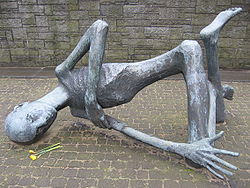
Neuengamme
The Neuengamme concentration camp, a Nazi concentration camp, was established in 1938 by the SS near the village of Neuengamme in Bergedorf district within the City of Hamburg, Germany. It was in operation from 1938 to 1945. By the end of the war, more than half of its estimated 106,000 prisoners...
in Bergedorf
Bergedorf
Bergedorf is the largest of the seven boroughs of Hamburg, Germany and a quarter within this borough. In 2006 the population of the borough was 118,942.-History:...
district within the City of Hamburg
Hamburg
-History:The first historic name for the city was, according to Claudius Ptolemy's reports, Treva.But the city takes its modern name, Hamburg, from the first permanent building on the site, a castle whose construction was ordered by the Emperor Charlemagne in AD 808...
, Germany
Germany
Germany , officially the Federal Republic of Germany , is a federal parliamentary republic in Europe. The country consists of 16 states while the capital and largest city is Berlin. Germany covers an area of 357,021 km2 and has a largely temperate seasonal climate...
. It was in operation from 1938 to 1945. By the end of the war, more than half of its estimated 106,000 prisoners had died. After being used for two prisons by the Hamburg authorities from 1948 to 2004, the site now serves as a memorial. It is situated 15 km southeast of the centre of Hamburg
Hamburg
-History:The first historic name for the city was, according to Claudius Ptolemy's reports, Treva.But the city takes its modern name, Hamburg, from the first permanent building on the site, a castle whose construction was ordered by the Emperor Charlemagne in AD 808...
in the Vierlande area.
Extermination through labour
The camp served the needs of the German war machine and also carried out exterminations through labour. The inmates were spread over the main camp and approximately 80 subcamps across north Germany. At least 50,000 succumbed to the inhumane conditions in the camp from hard manual work with insufficient nutrition, extremely unhygienic conditions with widespread disease, and violence from the guards.Work at the mother camp was centered on the production of brick
Brick
A brick is a block of ceramic material used in masonry construction, usually laid using various kinds of mortar. It has been regarded as one of the longest lasting and strongest building materials used throughout history.-History:...
s. This included the construction of a canal
Canal
Canals are man-made channels for water. There are two types of canal:#Waterways: navigable transportation canals used for carrying ships and boats shipping goods and conveying people, further subdivided into two kinds:...
to transport the bricks to and from the site. Inmates had to excavate the heavy, peat
Peat
Peat is an accumulation of partially decayed vegetation matter or histosol. Peat forms in wetland bogs, moors, muskegs, pocosins, mires, and peat swamp forests. Peat is harvested as an important source of fuel in certain parts of the world...
y soil
Soil
Soil is a natural body consisting of layers of mineral constituents of variable thicknesses, which differ from the parent materials in their morphological, physical, chemical, and mineralogical characteristics...
with inadequate tools and regardless of weather conditions or their health state. From 1942, several armaments companies (e.g. Messap, Jastram, and Walther-Werke) established facilities directly next to the Neuengamme concentration camp.
Victims
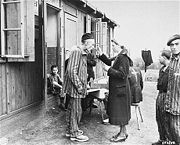
Poles
thumb|right|180px|The state flag of [[Poland]] as used by Polish government and diplomatic authoritiesThe Polish people, or Poles , are a nation indigenous to Poland. They are united by the Polish language, which belongs to the historical Lechitic subgroup of West Slavic languages of Central Europe...
(16,900), French
French people
The French are a nation that share a common French culture and speak the French language as a mother tongue. Historically, the French population are descended from peoples of Celtic, Latin and Germanic origin, and are today a mixture of several ethnic groups...
(11,500), German (9,200), Dutch
Dutch people
The Dutch people are an ethnic group native to the Netherlands. They share a common culture and speak the Dutch language. Dutch people and their descendants are found in migrant communities worldwide, notably in Suriname, Chile, Brazil, Canada, Australia, South Africa, New Zealand, and the United...
(6,950), Belgian (4,800), Danish (4,800)) and also from the local Jewish community, but also included communists, homosexuals, prostitutes, Gypsies, Jehovah's Witnesses
Jehovah's Witnesses
Jehovah's Witnesses is a millenarian restorationist Christian denomination with nontrinitarian beliefs distinct from mainstream Christianity. The religion reports worldwide membership of over 7 million adherents involved in evangelism, convention attendance of over 12 million, and annual...
, prisoners of war and many other persecuted groups. Of 106,000 inmates, almost half died. 20,400 victims, listed by name on the camp memorial Neuengamme, died in the camp and the subcamps. In actuality, an estimated 26,800 victims are known to have died there. During the last days of the camp and “evacuation” about 17,000 people died. At least 42,900 victims can be verified.
Inmates census
| Country | Men | Women | Total |
|---|---|---|---|
| Soviet Union Soviet Union The Soviet Union , officially the Union of Soviet Socialist Republics , was a constitutionally socialist state that existed in Eurasia between 1922 and 1991.... |
28,450 | 5,900 | 34,350 |
| Poland Poland Poland , officially the Republic of Poland , is a country in Central Europe bordered by Germany to the west; the Czech Republic and Slovakia to the south; Ukraine, Belarus and Lithuania to the east; and the Baltic Sea and Kaliningrad Oblast, a Russian exclave, to the north... |
13,000 | 3,900 | 16,900 |
| France France The French Republic , The French Republic , The French Republic , (commonly known as France , is a unitary semi-presidential republic in Western Europe with several overseas territories and islands located on other continents and in the Indian, Pacific, and Atlantic oceans. Metropolitan France... |
11,000 | 500 | 11,500 |
| Germany Germany Germany , officially the Federal Republic of Germany , is a federal parliamentary republic in Europe. The country consists of 16 states while the capital and largest city is Berlin. Germany covers an area of 357,021 km2 and has a largely temperate seasonal climate... |
8,800 | 400 | 9,200 |
| Netherlands Netherlands The Netherlands is a constituent country of the Kingdom of the Netherlands, located mainly in North-West Europe and with several islands in the Caribbean. Mainland Netherlands borders the North Sea to the north and west, Belgium to the south, and Germany to the east, and shares maritime borders... |
6,650 | 300 | 6,950 |
| Belgium Belgium Belgium , officially the Kingdom of Belgium, is a federal state in Western Europe. It is a founding member of the European Union and hosts the EU's headquarters, and those of several other major international organisations such as NATO.Belgium is also a member of, or affiliated to, many... |
4,500 | 300 | 4,800 |
| Denmark Denmark Denmark is a Scandinavian country in Northern Europe. The countries of Denmark and Greenland, as well as the Faroe Islands, constitute the Kingdom of Denmark . It is the southernmost of the Nordic countries, southwest of Sweden and south of Norway, and bordered to the south by Germany. Denmark... |
4,800 | - | 4,800 |
| Hungary Hungary Hungary , officially the Republic of Hungary , is a landlocked country in Central Europe. It is situated in the Carpathian Basin and is bordered by Slovakia to the north, Ukraine and Romania to the east, Serbia and Croatia to the south, Slovenia to the southwest and Austria to the west. The... |
1,400 | 1,200 | 2,600 |
| Norway Norway Norway , officially the Kingdom of Norway, is a Nordic unitary constitutional monarchy whose territory comprises the western portion of the Scandinavian Peninsula, Jan Mayen, and the Arctic archipelago of Svalbard and Bouvet Island. Norway has a total area of and a population of about 4.9 million... |
2,200 | - | 2,200 |
| Yugoslavia Yugoslavia Yugoslavia refers to three political entities that existed successively on the western part of the Balkans during most of the 20th century.... |
1,400 | 100 | 1,500 |
| Czechoslovakia Czechoslovakia Czechoslovakia or Czecho-Slovakia was a sovereign state in Central Europe which existed from October 1918, when it declared its independence from the Austro-Hungarian Empire, until 1992... |
800 | 580 | 1,380 |
| Greece Greece Greece , officially the Hellenic Republic , and historically Hellas or the Republic of Greece in English, is a country in southeastern Europe.... |
1,250 | - | 1,250 |
| Italy Italy Italy , officially the Italian Republic languages]] under the European Charter for Regional or Minority Languages. In each of these, Italy's official name is as follows:;;;;;;;;), is a unitary parliamentary republic in South-Central Europe. To the north it borders France, Switzerland, Austria and... |
850 | - | 850 |
| Spain Spain Spain , officially the Kingdom of Spain languages]] under the European Charter for Regional or Minority Languages. In each of these, Spain's official name is as follows:;;;;;;), is a country and member state of the European Union located in southwestern Europe on the Iberian Peninsula... |
750 | - | 750 |
| Austria Austria Austria , officially the Republic of Austria , is a landlocked country of roughly 8.4 million people in Central Europe. It is bordered by the Czech Republic and Germany to the north, Slovakia and Hungary to the east, Slovenia and Italy to the south, and Switzerland and Liechtenstein to the... |
300 | 20 | 320 |
| Luxembourg Luxembourg Luxembourg , officially the Grand Duchy of Luxembourg , is a landlocked country in western Europe, bordered by Belgium, France, and Germany. It has two principal regions: the Oesling in the North as part of the Ardennes massif, and the Gutland in the south... |
50 | - | 50 |
| Other countries | 1,300 | 300 | 1,600 |
| Overall | 87,500 | 13,500 | 101,000 |
| not officially on the lists | - | - | 5,000 |
| Global overall | - | - | 106,000 |
| Dead in deportation | - | - | 55,000 |
Well known inmates
- Rein BoomsmaRein BoomsmaReinder Boomsma was a Dutch footballer, who played for Sparta and the Dutch national team.-Biography:...
, Dutch footballer - Claude BourdetClaude BourdetClaude Bourdet , son of the dramatic author Édouard Bourdet, was a writer, journalist, polemist, and a militant French politician, who was born in 1909 and died in 1996 in Paris. He was a son of the poet Catherine Pozzi....
, French writer and politician - Emil František BurianEmil František BurianEmil František Burian was a Czech poet, journalist, singer, actor, musician, composer, dramatic adviser, playwright and director. He was also active in Communist Party of Czechoslovakia politics.- Life :...
, Czech poet, journalist, singer, actor, musician, composer, dramatic adviser, playwright and director - Ernst GoldenbaumErnst GoldenbaumErnst Goldenbaum was an East German politician.-Biography:Goldenbaum was born in Parchim. During World War I he served as a military and he participated in the German November Revolution...
, East German politician - Michel HollardMichel HollardMichel Hollard is a French wartime resister and engineer that founded the espionage group Réseau AGIR during World War II.His contribution was recognised by the British with the award of the Distinguished Service Order having "reconnoitered a number of heavily guarded V1 sites and reported on them"...
, French colonel and member of the French ResistanceFrench ResistanceThe French Resistance is the name used to denote the collection of French resistance movements that fought against the Nazi German occupation of France and against the collaborationist Vichy régime during World War II... - Anton de KomAnton de KomCornelis Gerard Anton de Kom was a Surinamese resistance fighter and anti-colonialist author.-Biography:...
, Surinamese resistance fighter - Henry Wilhelm KristiansenHenry Wilhelm KristiansenHenry Wilhelm Kristiansen was a Norwegian newspaper editor and politician for the Communist Party. He served as party chairman from 1931 to 1934, and then as editor-in-chief of the party organ Arbeideren from 1934 until 1940...
, Norwegian newspaper editor and politician - Léonel de MoustierLéonel de MoustierMarquis Léonel de Moustier was a French businessman and politician.Léonel Marie Ghislain Alfred de Moustier, son of Marquis Pierre de Moustier, was born in Paris. His father represented Doubs in the Chamber of Deputies and in the Senate...
, French politician - Sergei Nabokov, brother of writer Vladimir NabokovVladimir NabokovVladimir Vladimirovich Nabokov was a multilingual Russian novelist and short story writer. Nabokov wrote his first nine novels in Russian, then rose to international prominence as a master English prose stylist...
- Fritz PfefferFritz PfefferFriedrich "Fritz" Pfeffer was a German dentist and Jewish refugee who hid with Anne Frank during the Nazi Occupation of the Netherlands, and who perished in the Neuengamme concentration camp in Northern Germany...
German Jew, occupant of the Anne Frank HouseAnne Frank HouseThe Anne Frank House on Prinsengracht canal in Amsterdam, the Netherlands, is a museum dedicated to Jewish wartime diarist Anne Frank, who hid from Nazi persecution with her family and four other people in hidden rooms at the rear of the building... - David RoussetDavid RoussetDavid Rousset was a French writer and political activist, a recipient of Prix Renaudot, a French literary award....
, French writer and political activist - Kurt SchumacherKurt SchumacherDr. Kurt Schumacher , was chairman of the Social Democratic Party of Germany from 1946 and first Leader of the Opposition in the West German Bundestag parliament from 1949 until his death...
, German politician - Johann Trollmann, German boxer
Subcamps
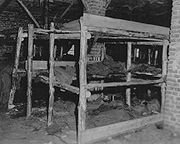
More than 80 subcamps were part of the Neuengamme concentration camp. First in 1942, inmates of Neuengamme were transported to the camp Arbeitsdorf. The dimensions of the camps differed from about 2,000 inmates to 10 or less. Several of these subcamps have memorials or at least plates, but as of 2000 at 28 locations there is nothing. Dr. Garbe, from the Memorial Museum of the Neuengamme concentration camp, wrote, "The importance of the satellite camps is further highlighted by the fact that toward the ends of the war three times more prisoners were in satellite camps than in the main camp."
Alderney concentration camps in Occupied British Commonwealth
The Channel IslandsOccupation of the Channel Islands
The Channel Islands were occupied by Nazi Germany for much of World War II, from 30 June 1940 until the liberation on 9 May 1945. The Channel Islands are two British Crown dependencies and include the bailiwicks of Guernsey and Jersey as well as the smaller islands of Alderney and Sark...
were the only part of the British Commonwealth
Commonwealth of Nations
The Commonwealth of Nations, normally referred to as the Commonwealth and formerly known as the British Commonwealth, is an intergovernmental organisation of fifty-four independent member states...
occupied by Nazi Germany
Nazi Germany
Nazi Germany , also known as the Third Reich , but officially called German Reich from 1933 to 1943 and Greater German Reich from 26 June 1943 onward, is the name commonly used to refer to the state of Germany from 1933 to 1945, when it was a totalitarian dictatorship ruled by...
. The Germans built four Neuengamme subcamps on Alderney Island
Alderney
Alderney is the most northerly of the Channel Islands. It is part of the Bailiwick of Guernsey, a British Crown dependency. It is long and wide. The area is , making it the third-largest island of the Channel Islands, and the second largest in the Bailiwick...
—the Alderney concentration camps
Alderney concentration camps
The Alderney concentration camps were prison camps built and operated by Nazi Germany during its World War II occupation of the Channel Islands. The Channel Islands were the only British Commonwealth soil to be occupied by the Nazis....
—and named them after the Frisian Islands
Frisian Islands
The Frisian Islands, also known as the Wadden Islands or Wadden Sea Islands, form an archipelago at the eastern edge of the North Sea in northwestern Europe, stretching from the north-west of the Netherlands through Germany to the west of Denmark...
: Lager Norderney
Lager Norderney
Lager Norderney was a Nazi concentration camp on Alderney, in the Channel Islands, named after the East Frisian island of Norderney.The Germans built four concentration camps on the island, subcamps of the Neuengamme concentration camp...
, Lager Borkum
Lager Borkum
Lager Borkum was a Nazi concentration camp on Alderney, in the Channel Islands, named after the East Frisian Island of Borkum.The Germans built four concentration camps on the island, subcamps of the Neuengamme concentration camp...
, Lager Sylt
Lager Sylt
Lager Sylt was a Nazi concentration camp on Alderney in the British Crown Dependency, the Channel Islands, in operation between March 1943 and June 1944. The Germans built one concentration camp and three Labour camps on the island, subcamps of the Neuengamme concentration camp...
and Lager Helgoland
Lager Helgoland
Lager Helgoland was a Nazi concentration camp on Alderney in the Channel Islands, named after the Frisian Island of Heligoland , formerly a Danish and then British possession located off the German North Sea coastline and belonging to Germany since 1890.The Germans built four concentration camps...
. The Nazi Organisation Todt
Organisation Todt
The Todt Organisation, was a Third Reich civil and military engineering group in Germany named after its founder, Fritz Todt, an engineer and senior Nazi figure...
operated each subcamp and used forced labour to build bunker
Bunker
A military bunker is a hardened shelter, often buried partly or fully underground, designed to protect the inhabitants from falling bombs or other attacks...
s, gun emplacements, air-raid shelters, and concrete fortifications. The Alderney concentration camps had a total inmate population of about 6,000.
Norderney camp housed Europe
Europe
Europe is, by convention, one of the world's seven continents. Comprising the westernmost peninsula of Eurasia, Europe is generally 'divided' from Asia to its east by the watershed divides of the Ural and Caucasus Mountains, the Ural River, the Caspian and Black Seas, and the waterways connecting...
an (usually Eastern but including Spaniard) and Russia
Russia
Russia or , officially known as both Russia and the Russian Federation , is a country in northern Eurasia. It is a federal semi-presidential republic, comprising 83 federal subjects...
n enforced labourers. The prisoners in Lager Norderney and Lager Sylt were slave labourers forced to build the many military fortifications and installations throughout Alderney. Sylt camp held Jewish enforced labourers and was a death camp. Lager Borkum was used for German technicians and volunteers from different countries of Europe
Europe
Europe is, by convention, one of the world's seven continents. Comprising the westernmost peninsula of Eurasia, Europe is generally 'divided' from Asia to its east by the watershed divides of the Ural and Caucasus Mountains, the Ural River, the Caspian and Black Seas, and the waterways connecting...
. Lager Helgoland was filled with Russia
Russia
Russia or , officially known as both Russia and the Russian Federation , is a country in northern Eurasia. It is a federal semi-presidential republic, comprising 83 federal subjects...
n Organisation Todt
Organisation Todt
The Todt Organisation, was a Third Reich civil and military engineering group in Germany named after its founder, Fritz Todt, an engineer and senior Nazi figure...
workers.
In 1942, Lager Norderney, containing Russian and Polish POWs, and Lager Sylt, holding Jews, were placed under the control of the SS Hauptsturmführer Max List. Over 700 of the inmates lost their lives before the camps were closed and the remaining inmates transferred to Germany
Nazi Germany
Nazi Germany , also known as the Third Reich , but officially called German Reich from 1933 to 1943 and Greater German Reich from 26 June 1943 onward, is the name commonly used to refer to the state of Germany from 1933 to 1945, when it was a totalitarian dictatorship ruled by...
in 1944.
Camp personnel
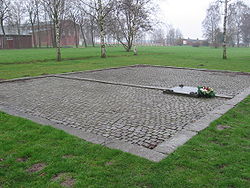
Wandsbek
Wandsbek is the second-largest of seven boroughs that make up the city of Hamburg, Germany. The name of the district is derived from the river Wandse which passes here. The quarter Wandsbek, which is the former independent city, is urban and, with the quarters Eilbek and Marienthal part of the...
and was nicknamed "The Dragon of Wandsbek" by the prisoners), Gertrud Heise, Frieda Ignatowitz, Gertrud Moeller, who also served at Boizenburg
Boizenburg
Boizenburg is a municipality in the Ludwigslust-Parchim district, in Mecklenburg-Western Pomerania, Germany. It is situated on the right bank of the Elbe, 53 km west of Ludwigslust, 25 km northeast of Lüneburg and 50 km east of Hamburg. Old Town is connected to the Elbe via a harbor...
subcamp, Lotte Johanna Radtke, chief wardress Annemie von der Huelst, Inge Marga Marggot Weber. Many of the women were later dispersed to female subcamps throughout northern Germany
Germany
Germany , officially the Federal Republic of Germany , is a federal parliamentary republic in Europe. The country consists of 16 states while the capital and largest city is Berlin. Germany covers an area of 357,021 km2 and has a largely temperate seasonal climate...
. Today it is known that female guards staffed the subcamps of Neuengamme at Boizenburg
Boizenburg
Boizenburg is a municipality in the Ludwigslust-Parchim district, in Mecklenburg-Western Pomerania, Germany. It is situated on the right bank of the Elbe, 53 km west of Ludwigslust, 25 km northeast of Lüneburg and 50 km east of Hamburg. Old Town is connected to the Elbe via a harbor...
, Braunschweig
Braunschweig
Braunschweig , is a city of 247,400 people, located in the federal-state of Lower Saxony, Germany. It is located north of the Harz mountains at the farthest navigable point of the Oker river, which connects to the North Sea via the rivers Aller and Weser....
SS-Reitschule, Hamburg-Sasel, Hamburg-Wandsbek, Helmstedt-Beendorf, Langenhorn
Langenhorn, Hamburg
Langenhorn is a quarter in the borough Hamburg-Nord of Hamburg, Germany. In 2006 the population was 40,425.-History:On January 25, 1332, Langenhorn was sold to Hamburg by the Count of Holstein...
, Neugraben
Neugraben-Fischbek
Neugraben-Fischbek is a quarter of Hamburg, Germany belongs to the borough Harburg. The quarter consists of the old settlements Neugraben and Fischbek, and the more recently constructed area Neuwiedenthal.-History:-History of Fischbek:...
, Obernheide, Salzwedel
Salzwedel
Salzwedel of Altmarkkreis Salzwedel, and has a population of approximately 21,500. Salzwedel is located on the German Framework Road.-Geography:...
, and Unterluss (Vuterluss). Only a few have been tried for war crimes, such as Anneliese Kohlmann, who served as one of only six woman guards at Neugraben.
Alfred Trzebinski
Alfred Trzebinski
Alfred Trzebinski was an SS-physician at the Auschwitz, Majdanek and Neuengamme concentration camps in Nazi Germany. He was sentenced to death and executed for his involvement in war crimes committed at the Neuengamme subcamps.-Life:Trzebinski was born in Jutroschin, Province of Posen...
(1902 – 1946) was an SS-physician, sentenced to death, and executed for his involvement in war crimes committed at the Neuengamme subcamps.
Camp Commanders
During the period as a sub-camp of the Sachsenhausen concentration campSachsenhausen concentration camp
Sachsenhausen or Sachsenhausen-Oranienburg was a Nazi concentration camp in Oranienburg, Germany, used primarily for political prisoners from 1936 to the end of the Third Reich in May, 1945. After World War II, when Oranienburg was in the Soviet Occupation Zone, the structure was used as an NKVD...
the following SS-officers served as Lagerführer:
- SS-SturmbannführerSturmbannführerSturmbannführer was a paramilitary rank of the Nazi Party equivalent to major, used both in the Sturmabteilung and the Schutzstaffel...
- Walter EisfeldWalter EisfeldWalter Eisfeld was a German Schutzstaffel officer and Nazi concentration camp commandant.... - SS-HauptsturmführerHauptsturmführerHauptsturmführer was a Nazi rank of the SS which was used between the years of 1934 and 1945. The rank of Hauptsturmführer was a mid-grade company level officer and was the equivalent of a Captain in the German Army and also the equivalent of captain in foreign armies...
- Martin Gottfried Weiß, April 1940 - June 1940
As an independent concentration camp from June 1940 the following were camp commanders:
- SS-HauptsturmführerHauptsturmführerHauptsturmführer was a Nazi rank of the SS which was used between the years of 1934 and 1945. The rank of Hauptsturmführer was a mid-grade company level officer and was the equivalent of a Captain in the German Army and also the equivalent of captain in foreign armies...
- Martin Gottfried Weiß, June 1940 - September 1942 - SS-ObersturmbannführerObersturmbannführerObersturmbannführer was a paramilitary Nazi Party rank used by both the SA and the SS. It was created in May 1933 to fill the need for an additional field grade officer rank above Sturmbannführer as the SA expanded. It became an SS rank at the same time...
- Max PaulyMax PaulyMax Pauly was an SS Sturmbannführer who was the commandant of Stutthof concentration camp from September, 1939 to August 1942 and commandant of Neuengamme concentration camp and the associated subcamps from September 1942 until liberation in May 1945.During his tenure as commandant of Neuengamme...
, September 1942 - until liberation
Timeline
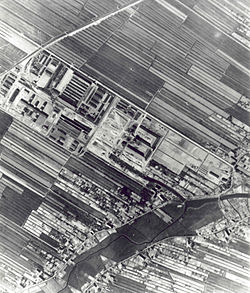
1938
In September 1938 the German Earth & Stone Works CompanyDEST
The D. E. S. T. , was an SS owned company originally created to procure and manufacture building materials for state construction projects in Nazi Germany DEST was a subsidiary company of Amtsgruppe W of SS-Wirtschafts- und Verwaltungshauptamt...
bought the defunct brickyard (German: Klinkerwerk) in Neuengamme. On December 13, 1938 the Neuengamme concentration camp was set up with 100 prisoners from the Sachsenhausen concentration camp
Sachsenhausen concentration camp
Sachsenhausen or Sachsenhausen-Oranienburg was a Nazi concentration camp in Oranienburg, Germany, used primarily for political prisoners from 1936 to the end of the Third Reich in May, 1945. After World War II, when Oranienburg was in the Soviet Occupation Zone, the structure was used as an NKVD...
.
1940
In April 1940, the SS and the city of Hamburg signed a contract for the construction of a larger brick factory, and on June 4, the Neuengamme concentration camp became an independent main camp.1942
According to the testimony of Wilhelm Bahr, an ex-medical orderly, during the trial against Bruno TeschBruno Tesch (Chemist)
Bruno Emil Tesch was a German chemist and entrepreneur. He was the co-inventor of the insecticide Zyklon B with Gerhard Peters and Walter Heerdt...
, 200 Russian prisoners of war
Prisoner of war
A prisoner of war or enemy prisoner of war is a person, whether civilian or combatant, who is held in custody by an enemy power during or immediately after an armed conflict...
were gassed by prussic acid in 1942. In April 1942, a crematorium
Cremation
Cremation is the process of reducing bodies to basic chemical compounds such as gasses and bone fragments. This is accomplished through high-temperature burning, vaporization and oxidation....
was constructed at the camp, prior all bodies were taken to Hamburg for cremation.
1943
In late 1943, most likely November, Neuengamme recorded its first female prisoners according to camp records.1944
In the summer of 1944, Neuengamme received many women prisoners from Auschwitz, as well other camps in the East. All of the women were eventually shipped out to one of its twenty-four female subcamps.In July 1944, a camp section for prominent prisoners from France was set up. These were political opponents and members of the French resistance
French Resistance
The French Resistance is the name used to denote the collection of French resistance movements that fought against the Nazi German occupation of France and against the collaborationist Vichy régime during World War II...
who had taken arms against German forces. They included John William, who had participated in the sabotaging and bombing of a military factory in Montluçon
Montluçon
Montluçon is a commune in central France. It is the largest commune in the Allier department, although the department's préfecture is located in the smaller town of Moulins. Its inhabitants are known as Montluçonnais...
. William discovered his singing voice while cheering his fellow prisoners at Neuengamme and went on to a prominent career as a singer of popular and gospel music
Gospel music
Gospel music is music that is written to express either personal, spiritual or a communal belief regarding Christian life, as well as to give a Christian alternative to mainstream secular music....
.
At the end of 1944 the total number of prisoners was around 49,000, with 12,000 in Neuengamme and 37,000 in the subcamps.
1945
On March 15, 1945, the transfer of Scandinavian prisoners from other camps to Neuengamme started. This was part of the White BusesWhite Buses
"White Buses" refers to a program undertaken by the Swedish Red Cross and the Danish government in the spring of 1945 to rescue concentration camp inmates in areas under Nazi control and transport them to Sweden, a neutral country...
program. On March 27, a Scandinavian camp was established at Neuengamme. On April 8, the air raid
Strategic bombing
Strategic bombing is a military strategy used in a total war with the goal of defeating an enemy nation-state by destroying its economic ability and public will to wage war rather than destroying its land or naval forces...
of a train with prisoners led to the Celler Hasenjagd
Celler Hasenjagd
The Celler Hasenjagd was a massacre of concentration camp inmates that took place in Celle, Prussian Hanover, in the last weeks of the Second World War...
massacre.
On April 26, 1945, about 10,000 surviving prisoners were loaded into four ships - the passenger liners Deutschland and Cap Arcona and two large steamers, SS Thielbek and Athen. The prisoners were in the ship's holds for several days without food or water.
The order to transfer the prisoners from the camps to the prison ships came from Hamburg
Hamburg
-History:The first historic name for the city was, according to Claudius Ptolemy's reports, Treva.But the city takes its modern name, Hamburg, from the first permanent building on the site, a castle whose construction was ordered by the Emperor Charlemagne in AD 808...
Gauleiter
Gauleiter
A Gauleiter was the party leader of a regional branch of the NSDAP or the head of a Gau or of a Reichsgau.-Creation and Early Usage:...
Karl Kaufmann
Karl Kaufmann
- External links :* in Der Deutsche Reichstag, Wahlperiode nach d. 30. Jan. 1933, Bd.: 1938, Berlin, 1938...
, who was himself acting on orders from Berlin. Kaufmann later claimed during a War Crimes Tribunal that the prisoners were destined for Sweden, however, at the same trial Bassewitz-Behr, the head of the Hamburg Gestapo, said that the prisoners were in fact slated to be killed in compliance with Himmler's orders, and it has been suggested that the plan called for scuttling the ships with the live prisoners still aboard.
On May 3, 1945, the ships were attacked by three squadrons of Royal Air Force
Royal Air Force
The Royal Air Force is the aerial warfare service branch of the British Armed Forces. Formed on 1 April 1918, it is the oldest independent air force in the world...
Hawker Typhoon
Hawker Typhoon
The Hawker Typhoon was a British single-seat fighter-bomber, produced by Hawker Aircraft. While the Typhoon was designed to be a medium-high altitude interceptor, and a direct replacement for the Hawker Hurricane, several design problems were encountered, and the Typhoon never completely satisfied...
s. The RAF believed the ships carried SS
Schutzstaffel
The Schutzstaffel |Sig runes]]) was a major paramilitary organization under Adolf Hitler and the Nazi Party. Built upon the Nazi ideology, the SS under Heinrich Himmler's command was responsible for many of the crimes against humanity during World War II...
personnel who were being transferred to Norway
Norway
Norway , officially the Kingdom of Norway, is a Nordic unitary constitutional monarchy whose territory comprises the western portion of the Scandinavian Peninsula, Jan Mayen, and the Arctic archipelago of Svalbard and Bouvet Island. Norway has a total area of and a population of about 4.9 million...
, intelligence that the ships carried concentration camp prisoners did not reach the squadrons in time to halt the attack. The Thielbek was sunk and the Cap Arcona and Deutschland set on fire, they both later sank; survivors who jumped into the water were strafed with canon-fire by the RAF aircraft. Thousands of dead were washed ashore just as the British Army occupied the area; the British forced German prisoners-of-war and civilians to dig mass graves to dispose of the bodies
On May 2, 1945 the SS and the last prisoners left the Neuengamme camp.
After the war
Following the end of the war, the camp was initially used as a Russian DP (Displaced personDisplaced person
A displaced person is a person who has been forced to leave his or her native place, a phenomenon known as forced migration.- Origin of term :...
s) Camp, German prisoners of war were held separately. After June 1945 the camp was used by the British forces
British Army
The British Army is the land warfare branch of Her Majesty's Armed Forces in the United Kingdom. It came into being with the unification of the Kingdom of England and Scotland into the Kingdom of Great Britain in 1707. The new British Army incorporated Regiments that had already existed in England...
as an internment camp for SS members and Nazi officials.
Following guilty verdicts given in the Neuengamme War Trials, on 8 October 1946 British executioner Albert Pierrepoint
Albert Pierrepoint
Albert Pierrepoint is the most famous member of the family which provided three of the United Kingdom's official hangmen in the first half of the 20th century...
hanged the following 11 people at Hamelin
Hamelin
Hamelin is a town on the river Weser in Lower Saxony, Germany. It is the capital of the district of Hamelin-Pyrmont and has a population of 58,696 ....
Prison for war crime
War crime
War crimes are serious violations of the laws applicable in armed conflict giving rise to individual criminal responsibility...
s perpetrated at Neuengamme concentration camp during the war:
- Max Pauly
- SS Dr Bruno Kitt
- Anton Thumann
- Johann Reese
- Willy Warnke
- SS Dr Alfred TrzebinskiAlfred TrzebinskiAlfred Trzebinski was an SS-physician at the Auschwitz, Majdanek and Neuengamme concentration camps in Nazi Germany. He was sentenced to death and executed for his involvement in war crimes committed at the Neuengamme subcamps.-Life:Trzebinski was born in Jutroschin, Province of Posen...
- Heinrich Ruge
- Wilhem Bahr
- Andreas Brems
- Wilhelm Dreimann
- Adolf Speck
Others convicted of crimes committed at Neuengamme received varying terms of imprisonment.
The Civil Internment Camp No. 6 was closed on 13 August 1948. Since 1948 the city of Hamburg used the camp as a prison. Several original buildings of the camp continued to serve as locations in this prison (for example Building Number 9), until February 2006. Since the demolition of the new-build structures in 2007 the whole area is used as a memorial.
Memorial
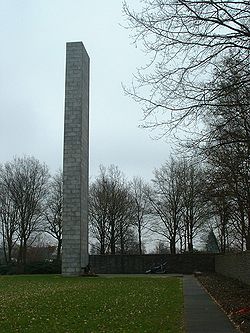
Fuhlsbüttel
Fuhlsbüttel is an urban quarter in the north of Hamburg, Germany in the district Hamburg-Nord. It is known as the site of Hamburg's international airport, and as the location of a prison which served as a concentration camp in the Nazi system of repression....
and Sasel, and in the Bullenhuser Damm
Bullenhuser Damm
Bullenhuser Damm School is located at 92–94 Bullenhuser Damm, a street in the Rothenburgsort section of Hamburg, Germany. During heavy air raids many portions of Hamburg were destroyed including the Rothenburgsort section which received heavy damage. The school was only partly damaged. By 1943 the...
school, where a number of children were murdered after being subjected to medical experiments.
Three of the camp's outposts also serve as public memorials. These are located at Bullenhuser Damm, Kritenbarg 8
Poppenbüttel
Poppenbüttel is a quarter in the borough Wandsbek of Hamburg, Germany. In 2006 the population was 21,930.-History:Poppenbüttel became a part of Hamburg in 1937....
and Suhrenkamp 98
Fuhlsbüttel
Fuhlsbüttel is an urban quarter in the north of Hamburg, Germany in the district Hamburg-Nord. It is known as the site of Hamburg's international airport, and as the location of a prison which served as a concentration camp in the Nazi system of repression....
.
The first of these is a memorial to the murder of 20 children from the Auschwitz concentration camp who had been taken to the main camp at Neuengamme and abused for medical experiments. On April 20, 1945, only weeks before the war was over, they were killed at the Bullenhuser Damm school in Hamburg to cover up that crime. The second is an outpost of Neuengamme concentration camp in Hamburg-Sasel where Jewish women from the Łódź Ghetto in Poland
Poland
Poland , officially the Republic of Poland , is a country in Central Europe bordered by Germany to the west; the Czech Republic and Slovakia to the south; Ukraine, Belarus and Lithuania to the east; and the Baltic Sea and Kaliningrad Oblast, a Russian exclave, to the north...
were forced to do construction work. The third one is located inside the gatehouse of the Fuhlsbüttel
Fuhlsbüttel
Fuhlsbüttel is an urban quarter in the north of Hamburg, Germany in the district Hamburg-Nord. It is known as the site of Hamburg's international airport, and as the location of a prison which served as a concentration camp in the Nazi system of repression....
penitentiary. Parts of this complex served as concentration camp for communists, opponents of the regime and many other groups. About 450 inmates were murdered here during the Nazi reign.
Ongoing historical research
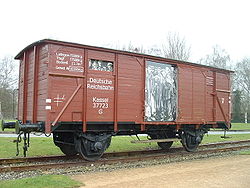
Schutzstaffel
The Schutzstaffel |Sig runes]]) was a major paramilitary organization under Adolf Hitler and the Nazi Party. Built upon the Nazi ideology, the SS under Heinrich Himmler's command was responsible for many of the crimes against humanity during World War II...
in 1945 and the transportation of inmates to other subcamps or other working locations, the historical work is difficult and ongoing. For example: in 1967 the German Federal Ministry of Justice
Federal Ministry of Justice (Germany)
The Federal Ministry of Justice is a federal ministry in Germany.Under the federal system of Germany, individual states are most responsible for the administration of justice and the application of penalties. The Federal Ministry of Justice devotes itself to creating and changing law in the...
stated the camp from September 1, 1938 until May 5, 1945. In 2008, the organisation of the Neuengamme memorial site (German: KZ-Gedenkstätte Neuengamme)—an establishment of the Hamburg Ministry of Culture, Sports and Media—stated that the empty camp was explored by British forces on May 2, 1945 and the last inmates were liberated in Flensburg
Flensburg
Flensburg is an independent town in the north of the German state of Schleswig-Holstein. Flensburg is the centre of the region of Southern Schleswig...
on May 10, 1945. The United States Holocaust Memorial Museum
United States Holocaust Memorial Museum
The United States Holocaust Memorial Museum is the United States' official memorial to the Holocaust. Adjacent to the National Mall in Washington, D.C., the USHMM provides for the documentation, study, and interpretation of Holocaust history...
stated that the camp was established on December 13, 1938 and liberated on May 4, 1945.
See also
- List of Nazi-German concentration camps
- SS Cap ArconaSS Cap ArconaThe Cap Arcona was a large German luxury ocean liner, formerly of the Hamburg-South America line. It transported passengers between Germany and South America up until 1940 when it was taken over by the German Navy....
- Celler HasenjagdCeller HasenjagdThe Celler Hasenjagd was a massacre of concentration camp inmates that took place in Celle, Prussian Hanover, in the last weeks of the Second World War...
(Massacre in Celle after an air raid)

